Archive for November, 2013
Hungarians welcome baby born to “brain dead” mother
BY IMRE TÉGLÁSY, PH.D., Fri Nov 22, 2013
November 21, 2013 (HLI) – In a very rare event earlier this year, a pregnant woman in Hungary who was declared “brain dead” was kept alive for three months on life support by doctors until her baby could be safely born.
The 31-year-old expectant mother suffered a stroke and was transported by a helicopter to the Neurological Clinic of Debrecen in Eastern Hungary. While the surgery was initially considered a success, sadly, she was declared brain dead two days later. An ultrasound showed that her 15-week-old preborn child was alive and very active.
“In the first two days we fought to save the mother’s life and it was proven … that circulation and functions stopped,” said Dr. Béla Fülesdi, president of the University of Debrecen Medical and Health Science Centre. “On the second day when [other] examinations were carried out, we found the baby was alive and kicking well in its mother’s body.”
Photo taken in Debrecen, Hungary on June 1 (the Day of Life declared by the UN) when we walked to the Ob-Gyn Clinic of University of Debrecen. The text reads: Peace in the womb! Amnesty for us – amnesty for our children before birth!
Dr. Tamás Szilveszter Kovács, one of the physicians who cared for the mother and child, struggled for a time over the situation, as he was unsure whether helping a baby live when the mother died was in the best interests of the child. But after meeting with the father and grandparents he changed his mind: “They convinced me that the child would mean, paradoxically, a special surviving of the mother for the grieving father and the grandparents. So the child will be reared in a complete family, and we would commit a sin if we would not do everything we could for them that modern science makes possible.”
The father and maternal grandparents of the child together asked doctors to keep the mother alive in an effort to save the child until he could be delivered safely.
Every provision possible was taken to try to give the child the best chance possible at developing naturally and safely. The father and grandparents came three times a week from the countryside to the hospital to talk to the baby and caressed the belly of the mother. A music therapist was even employed to stimulate the baby’s healthy development.
Doctors had to fight numerous infections and, as they would with any patient who was unable to move, would rotate her in order to avoid bedsores. While they were hoping to keep the child in the womb as long as possible, in the 27th week, the mother’s circulation became unstable and so they decided to deliver the baby because the womb was no longer safe. So at 27 weeks, the baby was delivered by cesarean section in July of this year, weighing just 1.4 kilograms (3 pounds, 1.8 ounces). The Hungarian doctors who delivered the baby in July believe the birth is one of only three such cases in history, in which the mother was kept alive medically for an extended period in order to save the child in her womb.
The baby was discharged from the hospital last month but doctors wanted to wait to make the announcement about the delivery until they were sure the baby would survive.
He (the sex of the child is not known) is now developing well at home and doctors say he does not show any illnesses related to premature births although he will be continuously monitored.
The father, grandparents and medical professionals who made this extraordinary situation possible deserve the highest respect for making difficult decisions in a very trying environment.
As pro-life professor Dr. Fülesdi said, “I am happy that this team representing the unit of care and several medical experts was a community as well, which was able to pass this dramatic test of 92 days not just from the point of view of medicine but from the spiritual one as well.”
Further evidence for this kind of spiritual awakening can be seen in Hungary’s “Easter Constitution,” enacted in January 2012 as the first national post-Communist constitution. With this serious move toward national independence and sovereignty, Hungary has begun to reclaim its Christian roots, including respect for life, religious freedom, marriage and family. Its pro-life provisions do not yet have the full effect of law, but we pray that this process may be hastened, especially since Hungary continues to suffer spiritually, economically and demographically from decades of oppression and abortion.
Amidst acknowledging the heroic efforts of the family and doctors that saw to it that this small child was welcomed into life, we also mourn a mother who would not live to meet her child face to face. As tragic as this is, it bodes well for the child that so many in his young life have demonstrated such great love and care for his well-being. Let this serve as an example to all of the great harmony between being open to life, and providing the best care possible for everyone.
Reprinted with permission from HLI
What does Blessed Miguel Pro have in common with victims of abortion?
BY JOHN JANSEN, Fri Nov 22, 2013 12:27 EST
Whenever we go out on the streets for a “Face the Truth” Tour, we can always count on someone happening by our display to tell us that by showing the pictures of abortion victims in the public square, we’re doing more harm than good. This is a charge we’ve heard often enough that we address it as one of the most Common Objections we hear.
In our response to this oft-raised argument, we plainly make the observation that throughout modern history, any number of successful social reform movements — from the movement to enact child labor laws to the civil rights movement — have used disturbing images that depict victims of maltreatment and violence, and that public support for the reforms these movements sought could not have been garnered without publicly showing these images.
Putting a Human Face on the Victims
The intent behind displaying graphic abortion pictures is the same, of course, for it puts a human face on the victims of what is, for far too many people, merely a theoretical concept or political issue.
Lewis Hine believed it was necessary to show victims of cruelty of the child labor industry, and Mamie Till believed it was necessary to have an open-casket funeral for her son Emmett after he was brutally murdered by violent racists.
We display pictures of abortion victims for the same reason: because they work. That is, in the eyes of the viewer, the images elicit sympathy for the victims of injustice.
In the case of reform movements that have employed the use of graphic pictures in working to effect social change, it perhaps goes without saying that one commonality these movements share is that it is members of the movements themselves that are the ones who initially seek to disseminate them.
However, a movement closely associated with one of the martyrs whose feast day the Catholic Church celebrates tomorrow provides an exception to this rule.
The Murder of Blessed Miguel Pro, S.J.
During the 1920s, Mexico was ruled by the virulently anti-Catholic President Plutarco Calles, who began what Graham Greene called “the fiercest persecution of religion anywhere since the reign of Elizabeth.” Chief among the many Catholic groups who vigorously opposed Calles were the Cristero rebels, whose story is depicted in the 2012 film For Greater Glory.
One of the most well known Cristeros, Blessed Miguel Pro, S.J., was falsely implicated in an assassination attempt on former Mexican President Álvaro Obregón in November 1927, which provided the Calles regime with the pretext for ordering his death.
Father Pro went to his execution on November 23, 1927. Before the firing squad was ordered to shoot, Fr. Pro raised his arms in cruciform and shouted the cry of the Cristeros, “Viva Cristo Rey!”(“Long live Christ the King!”) After the first shots of the firing squad failed to kill him, a soldier shot him point blank in the head.
Calles, seeking to cow other Cristeros into submission, had the execution photographed, and newspapers throughout Mexico carried pictures of the executed priest on their front page the next day. (As George Weigel has observed, Blessed Miguel Pro was likely the first martyr ever to be photographed at the very moment of his death.)
But Calles’ plan backfired. Instead, the images of Pro’s murder further emboldened the Cristeros to stand up to his oppressive regime.
Graphic Images Work, Regardless of the Intentions of Those Displaying Them
This instance of a public display of graphic images of violence is unique in that the initial act of displaying the images was done by the perpetrators themselves, and not by sympathizers of the victims. Yet the act of displaying these shocking images still played a major role in combating injustices committed by the perpetrators, proving that regardless of the motivations behind displaying graphic images of violence and injustice, their effect is the same.
Pro-Life Action League National Director Joe Scheidler has often remarked that seeing a picture of an aborted baby in the fall of 1972 — just a few months before the Supreme Court’s Roe v. Wadedecision — was the impetus for him to commit himself to full-time pro-life work. Along these same lines, I can’t tell you how many times we’ve heard from passersby at our Face the Truth demonstrations comments along the lines of, “I had no idea what abortion was until I saw your signs.”
Because of the overwhelming evidence that graphic pictures do elicit sympathy for the victims of injustice in the eyes of the public, we can surely be confident of their inestimable value in the fight against abortion.
Reprinted with permission from Pro-Life Action League
How the decline of marriage and religious belief hurts children
BY COLLETTE CAPRARA, Thu Nov 21, 2013
November 15, 2013 (Heritage) – Analysts at a recent forum on the downward trends in marriage and religion in the United States agree that the two are not isolated phenomena but, in fact, influence and exacerbate one another.
Brad Wilcox, director of the National Marriage Project, has shown that family dissolution is linked to a further erosion of civil society in which American men are increasingly disconnected from core cultural institutions, including a religious congregation. Likewise, Mary Eberstadt, a senior fellow at the Ethics and Public Policy Center, has found that marriage and family life often engender an impulse for religious engagement and that, as more couples cohabit, divorce, or never marry, religious participation has decreased.
The impact of the downturns in family formation and religious practice have real-world and long-term implications for the lives of Americans—particularly the rising generation.
Children raised by two married, biological parents tend to fare better than peers in other households. Those who grow up in married-parent families are 82 percent less likely to live in poverty, and intact families tend to fare better in a wide range of economic measures. Youth who are raised in an intact family tend to fare better on a range of emotional and psychological outcomes, have higher levels ofacademic achievement and educational attainment, and are less likely to engage in high-risk behaviors such as sexual activity or substance abuse and less likely to exhibit anti-social behavior.
Like family structure, religious affiliation and participation is linked to the well-being of individuals, families, and society. Children whose mothers more frequently participated in religious activities are less likely to exhibit aggressive and delinquent behavior. Religious practice is associated with higher levels of economic well-being and academic performance as well reductions in the incidence of crime, delinquency, drug and alcohol addiction, and problems related to physical and emotional health. Coupled with the association between religiosity, empathy, charity, and volunteerism, the improved prospects of more religious and intact families can have positive ripple effects throughout society.
Given the wide-ranging and mutually supporting benefits of religion and family, it is critical for the public interest to bolster both—and a starting point would be to support policies that promote marriage and strengthen families.
Reprinted with permission from Heritage
When the Archbishop Met the President
Cardinal Dolan thought he heard Barack Obama pledge respect for the Catholic Church’s rights of conscience.
Then came the contraception coverage mandate.
By James Taranto, March 31, 2012, New York
The president of the U.S. Conference of Bishops is careful to show due respect for the president of the United States. “I was deeply honored that he would call me and discuss these things with me,” says the newly elevated Cardinal Timothy Dolan, archbishop of New York. But when Archbishop Dolan tells me his account of their discussions of the ObamaCare birth-control mandate, Barack Obama sounds imperious and deceitful to me.
Mr. Obama knew that the mandate would pose difficulties for the Catholic Church, so he invited Archbishop Dolan to the Oval Office last November, shortly before the bishops’ General Assembly in Baltimore. At the end of their 45-minute discussion, the archbishop summed up what he understood as the president’s message:
“I said, ‘I’ve heard you say, first of all, that you have immense regard for the work of the Catholic Church in the United States in health care, education and charity. . . . I have heard you say that you are not going to let the administration do anything to impede that work and . . . that you take the protection of the rights of conscience with the utmost seriousness. . . . Does that accurately sum up our conversation?’ [Mr. Obama] said, ‘You bet it does.'”
The archbishop asked for permission to relay the message to the other bishops. “You don’t have my permission, you’ve got my request,” the president replied.
“So you can imagine the chagrin,” Archbishop Dolan continues, “when he called me at the end of January to say that the mandates remain in place and that there would be no substantive change, and that the only thing that he could offer me was that we would have until August. . . . I said, ‘Mr. President, I appreciate the call. Are you saying now that we have until August to introduce to you continual concerns that might trigger a substantive mitigation in these mandates?’ He said, ‘No, the mandates remain. We’re more or less giving you this time to find out how you’re going to be able to comply.’ I said, ‘Well, sir, we don’t need the [extra time]. I can tell you now we’re unable to comply.'”
The administration went ahead and announced the mandate. A public backlash ensued, and the archbishop got another call from the president on Feb. 10. “He said, ‘You will be happy to hear religious institutions do not have to pay for this, that the burden will be on insurers.'” Archbishop Dolan asked if the president was seeking his input and was told the modified policy was a fait accompli. The call came at 9:30 a.m. The president announced the purported accommodation at 12:15 p.m.
Editorial board member Joe Rago predicts how the Supreme Court will rule on ObamaCare’s Medicaid expansion and the law’s severability.
Sister Carol Keehan of the pro-ObamaCare Catholic Health Association immediately pronounced herself satisfied with the change, and the bishops felt pressure to say something. “We wanted to avoid two headlines. Headline 1 was ‘Bishops Celebrate . . . Accommodations.’ . . . The other headline we wanted to avoid is ‘Bishops Obstinate.'” They rushed out a “circumspect” statement, which Archbishop Dolan sums up as follows: “We welcome this initiative, we look forward to studying it, we hope that it’s a decent first step, but we still have very weighty questions.”
Within hours, “it dawned on us that there’s not much here, and that’s when we put out the more substantive [statement] by the end of the day, saying, ‘Whoa, now we’ve had time to hear what was said at the announcement and to read the substance of it, and this just doesn’t do it.'”
Having rushed to conciliate, they got the “Bishops Obstinate” headlines anyway. Archbishop Dolan explains that the “accommodation” solves nothing, since most church-affiliated organizations either are self-insured or purchase coverage from Catholic insurance companies like Christian Brothers Services and Catholic Mutual Group, which also see the mandate as “morally toxic.” He argues that the mandate also infringes on the religious liberty of non-ministerial organizations like the Knights of Columbus and Catholic-oriented businesses such as publishing houses, not to mention individuals, Catholic or not, who conscientiously object.
“We’ve grown hoarse saying this is not about contraception, this is about religious freedom,” he says. What rankles him the most is the government’s narrow definition of a religious institution. Your local Catholic parish, for instance, is exempt from the birth-control mandate. Not exempt are institutions such as hospitals, grade schools, universities and soup kitchens that employ or serve significant numbers of people from other faiths and whose main purpose is something other than proselytization.
“We find it completely unswallowable, both as Catholics and mostly as Americans, that a bureau of the American government would take it upon itself to define ‘ministry,'” Archbishop Dolan says. “We would find that to be—we’ve used the words ‘radical,’ ‘unprecedented’ and ‘dramatically intrusive.'”
It also amounts to penalizing the church for not discriminating in its good works: “We don’t ask people for their baptismal certificate, nor do we ask people for their U.S. passport, before we can serve them, OK? . . . We don’t serve people because they’re Catholic, we serve them because we are, and it’s a moral imperative for us to do so.”
To be sure, not all Catholics see it that way. Archbishop Dolan makes an argument—which he prefaces with the admission that “I find this a little uncomfortable”—that federal intrusion bolsters those who are more selfishly inclined: “Some Catholics . . . are now saying, ‘Fine, we’ll get out of all that. It’s dragging us down anyway. Rather than be supporting 50 Catholic schools in the inner city where most of the kids are not Catholic, and using a big chunk of diocesan money to do that, we’ll just use it for the schools that have all Catholics, and it’ll serve us a lot better.’ . . .
“I find that, by the way, to be rather un-Catholic,” he continues. “I don’t know what that would say to the gospel mandate to be ‘light to the world’ and ‘salt of the earth.’ It’s part of our religion to be right out there in the forefront, right there in the nitty-gritty.”
An insular attitude, Archbishop Dolan suggests, plays into the hands of ideologues who favor an ever-more-powerful secular government: “I get this all the time: I would have some people say, ‘Cardinal Dolan, you need to go to Albany and say, “If we don’t get state aid by September, I’m going to close all my schools.”‘ I say to them, ‘You don’t think there’d be somersaults up and down the corridors?'”
Another story comes from the nation’s capital: “The Archdiocese of Washington, in a very courteous way, went to the City Council and said, ‘We just want to be upfront with you. If this goes through that we have to place children up for adoption with same-sex couples, we’ll have to get out of the adoption enterprise, which everybody admits we probably do better than anybody else.’ And one of the City Council members said, ‘Good. We’ve been trying to get you out of it forever. And besides, we’re paying you to do it. So get out!'”
What about the argument that vast numbers of Catholics ignore the church’s teachings about sexuality? Doesn’t the church have a problem conveying its moral principles to its own flock? “Do we ever!” the archbishop replies with a hearty laugh. “I’m not afraid to admit that we have an internal catechetical challenge—a towering one—in convincing our own people of the moral beauty and coherence of what we teach. That’s a biggie.”
For this he faults the church leadership. “We have gotten gun-shy . . . in speaking with any amount of cogency on chastity and sexual morality.” He dates this diffidence to “the mid- and late ’60s, when the whole world seemed to be caving in, and where Catholics in general got the impression that what the Second Vatican Council taught, first and foremost, is that we should be chums with the world, and that the best thing the church can do is become more and more like everybody else.”
The “flash point,” the archbishop says, was “Humanae Vitae,” Pope Paul VI’s 1968 encyclical reasserting the church’s teachings on sex, marriage and reproduction, including its opposition to artificial contraception. It “brought such a tsunami of dissent, departure, disapproval of the church, that I think most of us—and I’m using the first-person plural intentionally, including myself—kind of subconsciously said, ‘Whoa. We’d better never talk about that, because it’s just too hot to handle.’ We forfeited the chance to be a coherent moral voice when it comes to one of the more burning issues of the day.”
Without my having raised the subject, he adds that the church’s sex-abuse scandal “intensified our laryngitis over speaking about issues of chastity and sexual morality, because we almost thought, ‘I’ll blush if I do. . . . After what some priests and some bishops, albeit a tiny minority, have done, how will I have any credibility in speaking on that?'”
Yet the archbishop says he sees a hunger, especially among young adults, for a more authoritative church voice on sexuality. “They will be quick to say, ‘By the way, we want you to know that we might not be able to obey it. . . . But we want to hear it. And in justice, you as our pastors need to tell us, and you need to challenge us.'”
As we talk about sex, Archbishop Dolan makes a point of reiterating that his central objection to the ObamaCare mandate is that it violates religious liberty. In their views on that subject, and their role in politics more generally, American Catholics have in fact become “more like everybody else.” When John F. Kennedy ran for president in 1960, he found it necessary to reassure Protestants that, in the archbishop’s paraphrase, “my Catholic faith will not inspire my decisions in the White House.”
“That’s worrisome,” Archbishop Dolan says. “That’s a severe cleavage between one’s moral convictions and the judgments one is called upon to make. . . . It’s bothersome to us as Catholics, because that’s the kind of apologia that we expect of no other religion.” But times have changed. Today devout Catholic Rick Santorum is running on the promise that his faith will inform his decisions—and his greatest support comes from evangelical Protestants.
The archbishop sees a parallel irony in his dispute with Mr. Obama: “This is a strange turn of the table, that here a Catholic cardinal is defending religious freedom, the great proposition of the American republic, and the president of the United States seems to be saying that this is a less-than-important issue.”
Religious freedom has received a more sympathetic hearing at the U.S. Supreme Court—which, coincidentally, has had a Catholic majority since 2006. In January, inHosanna-Tabor v. EEOC, the court ruled unanimously in favor of an evangelical Lutheran church’s right to classify teachers as ministers and therefore not subject to federal employment law. Archbishop Dolan sums up the decision: “Nowhere, no how, no way can the federal government seek to intrude upon the internal identity of a religion in defining its ministers.”
But whether the government has the authority to define a ministry—excluding, as the ObamaCare mandate does, church-affiliated institutions like hospitals and schools—is a separate legal question, one that may be resolved in litigation over the birth-control mandate.
It’s possible that the Supreme Court or a new president will render the issue moot. After our interview, the archbishop has a question for me: If the high court rules against ObamaCare, will that be the end of the birth-control mandate? Probably not, I tell him—though such an outcome seems much likelier now than it did early in the week when we met. The justices could end up striking a blow for religious liberty without the question even having reached their docket.
Mr. Taranto, a member of the Journal’s editorial board, writes the Best of the Web Today column for OpinionJournal.com.
Don’t abort your sick child, urges mom told her baby would die
BY OPERATION RESCUE STAFF, Mon Nov 18, 2013
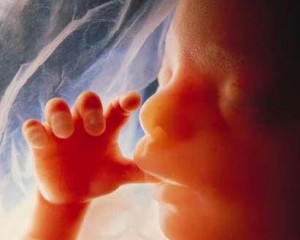 Albuquerque, NM, Nov. 18, 2013 (OperationRescue) — On the weekend before a municipal election that will determine if Albuquerque, New Mexico, will become the first city in the nation to ban abortions after 20 weeks, a woman has come forward in a new video to tell why, when faced with a prenatal diagnosis of a child with severe fetal anomalies, she heroically rejected pressure to abort her son, Chance.
Albuquerque, NM, Nov. 18, 2013 (OperationRescue) — On the weekend before a municipal election that will determine if Albuquerque, New Mexico, will become the first city in the nation to ban abortions after 20 weeks, a woman has come forward in a new video to tell why, when faced with a prenatal diagnosis of a child with severe fetal anomalies, she heroically rejected pressure to abort her son, Chance.
Calling the bid to end late-term abortion a “humanitarian issue,” Chantel Stuckman told of the heart-wrenching moment when she and her husband were told that her 24 week pre-born son had deformities so severe that he was not expected to live. While her doctors did not demand that she abort, they pressured her to rapidly make a life-or-death decision.
Chantel, who had an abortion as a teen that she deeply regrets, says she knew that this baby must be given a chance at life, however slim.
“Chance was diagnosed with hydrocephaly and other conditions that often lead to abortions out of a misguided concern that the don’t want their child to suffer,” said Tara Shaver, Chairperson of ABQ Voters For Late Term Abortion Ban. “Aborting babies who are sick or disabled isn’t something a compassionate society should do. We should let life take its course, and when we do, sometimes unexpected blessings come from what seems at first like tragedy.”
Chantel agrees, noting that doctors told her that her son would not survive, but he did. They said he would never walk, talk, or read, but he can do all three.
“I think that all children struggle,” said Chantell. “And I don’t think that killing them is ever our first option. I don’t think we look at a child who’s going through drug abuse and say, ‘You know, they’re really struggling. Maybe it would be better if I killed him.’ I don’t think we look at a child who is diagnosed with a terminal illness and say, ‘Well, maybe we should just kill him because their suffering is going to be too much.’ So I don’t see the fact that a child may or may not suffer as a reason to end their life.”
Today, Chance is a happy 14-year old teen who is a joy to all who know him.
Chantel says she supports the Pain Capable Unborn Child Protection Ordinance because she understands more than most the heartbreak of a poor fetal diagnosis – and that abortion is not the answer. In a new video, produced by Shaver and Cheryl Sullenger of Operation Rescue, Chantel urges Albuquerque voters to support the Pain Capable Unborn Child Protection Ordinance for the sake of children like Chance.
Watch this video of Chantel Stuckman describing her experience having a child diagnosed with abnormalities too severe to survive: http://www.youtube.com/watch?feature=player_embedded&v=xhUaaMQaF28
From a horrific rape, a priceless ‘diamond in the rough’: Monica’s story
By Peter Baklinski, Mon Nov 11, 2013
WOODBURN, Indiana, November 8, 2013 (LifeSiteNews.com) – The 17-year-old woman had been terrorized, humiliated and crushed by what had happened to her. She had been raped. Now, to make matters worse, she was pregnant. Her mother had forced her to visit a back alley abortionist, to solve “the problem.” But at the last moment, Sandy decided not to go through with the illegal procedure. The year was 1972.Two weeks later, Sandy’s father suddenly died. Her entire world had now completely come crashing down upon her. All she wanted was her life back. All she could wonder was what was to become of her and the little new life beginning to stir inside her…
Last month something remarkable happened to Monica Kelsey, 40, that confirmed to her that no life, no matter how it came to be, is a mistake: She found a diamond in a field of plowed dirt.
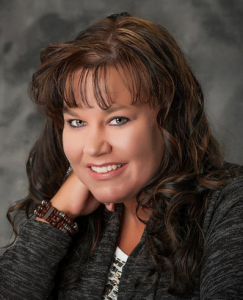 Monica had been abandoned by her raped birthmother, Sandy, at a hospital two hours after being born and was soon adopted. She grew up completely unaware of her turbulent beginnings. It was only three years ago that she connected with her birthmother and heard the true account of her life for the first time.
Monica had been abandoned by her raped birthmother, Sandy, at a hospital two hours after being born and was soon adopted. She grew up completely unaware of her turbulent beginnings. It was only three years ago that she connected with her birthmother and heard the true account of her life for the first time.
“When I found my birthmother she said to me: ‘It’s amazing how something so beautiful has come out of something so horrible,’” Monica said in an interview with LifeSiteNews.com.
When Sandy unexpectedly passed away this past March, Monica connected with relatives at the funeral who had not even known of her existence. “I prayed for a relationship with my birth family,” Monica said. “When I finally found them, no one knew about me. I was literally the family secret.”
Monica decided to travel from her home in Indiana to Arkansas last month to explore her roots. She wanted to experience for herself the sights and sounds that had been a part of her birthmother’s life.
During her stay, Monica and a few of her newly discovered relatives decided to try their luck treasure hunting at Crater of Diamonds State Park in Arkansas, the only diamond-producing site in the world where the public can find real diamonds and keep them.
Geologists believe that a volcano brought the diamonds to the surface about 100 million years ago. Diamonds form deep in the earth at extremely high temperatures and pressures. Less than one percent of the 150,000 visitors to the park each year find a diamond.
After two hours of poking about the 37 acres of plowed eroded volcanic surface at the park, the group, with wet clothes and dirty shoes, decided to call it a day. But as Monica went to pick up her bucket and join her newfound family, she noticed something on the ground glimmering in the sunlight. Stooping to pick it up, she knew immediately what she had found: a yellow diamond.
“It’s amazing how I found this shining sparkling diamond in a field of dirt,” she said.
Park staff confirmed the find. The diamond, the 400th found that year, weighed just over half a carat (56 points).
For Monica, finding the diamond was filled with the deepest significance. It suddenly dawned on her that she, conceived in the horrible act of rape, was really her birthmother’s “diamond in the rough”.
“I did correlate finding this diamond as a kind of sign that my life [despite its rough beginnings] is still shining, that the sparkle is still there,” she said. “God took my birthmother’s deepest pain and turned it into the most precious of jewels.”
“I just praise God that my birthmother was strong enough to walk out of the abortion clinic,” she said.
Monica, a firefighter and medic who is married with three children, has become a public advocate for children conceived in rape after first learning of her beginnings.
She said that she used to be against abortion “except in the case of rape” – that is, until she “became educated.” Now she will tell anyone who will listen that her life “isn’t any different than your life simply because of the way I was conceived.”
Monica will gently tell people that “abortion has never fixed a rape, it never has and it never will.”
“Abortion just adds more trauma to rape and makes the child a victim as well, but unfortunately by the mother’s own hands,” she said.
Monica believes that women who become pregnant by rape should think about the new life flourishing inside them as their own “diamond in the rough.”
“There is a diamond in this pregnancy that will shine later on, you just have to let it grow,” she said. “Girls today don’t give themselves enough credit about how strong they can be.”
Monica plans to make a necklace with her diamond, leaving it uncut. She will wear it in memory of her birthmother’s sacrifice to give her the greatest gifts of all, life and her adoptive family.
“She is my hero, she truly is.”
Monica says she has nothing but gratitude for the choices her raped mother made.
“Life is sacred. Life is precious. Life is a gift. Thank you, Lord, for my birthmother.”
Follow Monica’s pro-life work on her website and on her Facebook page.
Pope Francis Applauded for Kissing, Blessing Disabled Man Covered With Tumors
by Steven Ertelt | The Vatican | LifeNews.com | 11/7/13
The praise for Pope Francis since becoming the leader of the Catholic Church has been consistent over the last several months. Catholics and Protestants alike have showered him with praise for not only his pro-life position but his willingness to show extended love and support for the disabled.
Just days after getting international acclaim for letting a teen with Down Syndrome take a spin in the Popemobile, Pope Francis is drawing accolades for showing love to a disabled man covered in boils.The Pope wasted no time in kissing and blessing the man.
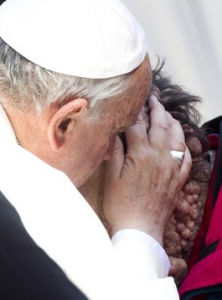 Bill Hallowell at The Blaze has more on what happened:
Bill Hallowell at The Blaze has more on what happened:
On Wednesday, Pope Francis took the time to do one simple thing that has now captivated the globe: He embraced and prayed with a man who was covered in tumors in St. Peter’s Square.
The encounter between the pontiff and the unnamed individual reportedly unfolded after Pope Francis addressed his general audience and the man approached the Catholic leader and asked to be blessed.
The afflicted individual reportedly suffers from neurofibromatosis, a disease described by the Mayo Clinic as a “genetic disorder that disturbs cell growth in your nervous system, causing tumors to form on nerve tissue.”
While individuals suffering from neurofibromatosis are sometimes shunned as a result of their appearance, Pope Francis wasted no time kissing the man’s face, embracing him and offering up a blessing.
Neurofibromatosis is not contagious.
Baby Weighing Less Than a Can of Soda Heads Home From Hospital Soon
by Steven Ertelt | San Diego, CA | LifeNews.com | 11/7/13
Alexis Clarke weighed just 11 ounces at birth — smaller than a can of soda. That was six months ago, when she was delivered at UCSD Medical Center at just 25 weeks. The smallest baby ever born at the medical center, Alexis is only now finally able to head home.
After months of medical care, Alexis is now bigger and healthier — and her family has supported her each and every day.
The U.S. Senate saw the introduction of a bill today that will protect babies like Aleixs from abortions. It would ban abortions on unborn children starting at 20 weeks – just five weeks ahead of when Alexis was born.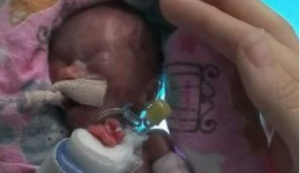
A local news report has more on this beautiful little girl:
“She was 11 ounces. So, she was 340-grams,” mother Laurie Clarke said, holding up the palm of her hand to describe just how small her little girl was at birth. “[She was] smaller than a can of soda. But when I got to see her, she was just our baby angel.”
Alexis was born three-and-a-half months early. According to her mother, doctors had to deliver Alexis early due to complications stemming from an under-developed placenta.
At Alexis’ small size, Clarke said her baby’s odds of survival were low – less than 25 percent. Given survival, doctors told Alexis’ family that her odds of significant and permanent complications were high.
For the first-time mother, watching her baby spend several months in an incubator meant an almost unbearable wait to just hold her child, and wonder what went wrong with the pregnancy.
“Honestly, it was a lot of, ‘What did I do wrong?’” said Clarke between tears. “Hearing that it wasn’t anything that I did definitely helped.”
According to the National Center for Health Statistics (NCHS), of the Centers for Disease Control and Prevention (CDC), babies born at 28 weeks or later survive 90 percent of the time.
Babies born between 24 and 27 weeks – as in Alexis’ case – survive 80 percent of the time.
Despite the precarious odds, Alexis, her parents and UCSD medical staff fought for her survival. For the first few months, Clarke said the situation was very much touch-and-go. Immediately, the baby was placed in the Neonatal Intensive Care Unit (NICU) at UCSD Medical Center, surrounded by nurses and doctors tending to her 24 hours a day, seven days a week.
If all goes according to plan, Clarke said her little girl will be released from the hospital and headed home for the first time ever by Thanksgiving.
“We have something definitely huge to be thankful for,” said Clarke.
Aborting My Baby With Down Syndrome Ruined My Life, Tore Apart My Family
by Steven Ertelt | Washington, DC | LifeNews.com | 11/8/13
Tens of millions of women who have had abortions over the last decades worldwide regret their abortions. Marie Ideson of England is one of them.
Every morning when she wakes up she misses the six-year-old little girl who she named Lillie and planned to give a wonderful life — than is until an amniocenteses discovered Lillie had Down Syndrome.
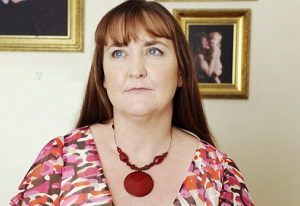 “Despite any disability, my daughter would have been incredibly well loved. And whatever her future was, I would always have been there for her,” Ideson tells the London Daily Mail newspaper.
“Despite any disability, my daughter would have been incredibly well loved. And whatever her future was, I would always have been there for her,” Ideson tells the London Daily Mail newspaper.
But that love will never be given out. Days playing in the rain, carting Lillie off to school, hugs and kisses, applying bandages to scrapped knees. They’re never happen, because Lillie is one of the millions of babies who have been killed by abortion.
Not only did the abortion take Lillie’s life and deprive Ideson of a daughter who could have blessed her life, it tore apart her family. She and her partner had another child but that didn’t save the relationship.
Yet when she was a little over 16 weeks pregnant with Lillie — and having been told by doctors that tests showed her much-wanted daughter had Down’s syndrome — Marie did something that still torments her and which she blames for the breakdown of her marriage: she underwent a termination.
‘Looking back, I was bullied into going ahead with an abortion,’ says Marie, 46, a GP surgery manager. ‘I only wish I could turn the clock back. I think of the daughter I never had every day. I will always regret it.’
‘When I said I wanted to keep the baby, I was told she could be born needing emergency heart surgery and have bowel and muscle tone problems — and that was if she survived.
‘At no time did anyone suggest we might keep our baby. A termination was presented as the only way forward.’
Not only that, but Marie also thinks she was made to feel guilty about wanting to continue with her pregnancy.
‘A nurse said not aborting my baby would cause it to suffer, and she’d only become a burden on society if I went ahead,’ says Marie. ‘She even said: “Ninety-nine per cent of women in your situation wouldn’t want the baby.” ’
About her husband, she says:
She adds: ‘It might sound unreasonable, but I blamed him as well as the doctors for the abortion. He knew I was anti-abortion and that I wanted to keep my baby.
‘I was upset that he had allowed me to take the pill and didn’t just take me home. I believed he’d sided with the consultant. And when Reuben arrived, I also realized nothing was going to bring Lillie back and a new baby couldn’t solve the issues in our marriage.’
By the time Reuben was two, the couple had split. Marie, who never signed a consent form for the abortion, spent thousands of pounds in legal fees in a bid to gain an apology from the hospital — although she was eventually forced to abandon legal action due to the expense.
Of her broken marriage she says: ‘I couldn’t get over what happened — neither of us could come to terms with it. The trauma was always there between Allan and I. The rift it caused just couldn’t be healed.’
She says: ‘My eldest sons are now aged 25. When pregnant with them, I knew of women having Down’s syndrome babies. But when I had Reuben, I heard of no one.
‘Today, I never see mums with Down’s syndrome babies. I can’t help feeling other women must be having abortions they don’t want. I can’t believe that everyone who finds out their baby has Down’s syndrome willingly chooses to abort it.’
“Death Panels” Are Euthanizing Patients Every Day as Doctors Make Treatment Decisions
by Bobby Schindler | Washington, DC | LifeNews.com | 11/4/13
Former Governor Sarah Palin, whether it was intentional or not, certainly began the discussion on end of life issues when she referred to “death panels” in a 2009 debate about federal health care legislation to cover the uninsured in the US.
Governor Palin was referring to death panels in the context of government officials making life and death decisions if/when the government took over our health care system.
However, what the general public doesn’t seem to realize is that death panels (if you want to use that label) already exist. Perhaps even more alarming, however is the extent that our medical rights have deteriorated due to an unrelenting anti-life agenda that has slowly transformed our laws – and our culture – into accepting the killing of our most medically vulnerable American citizens.
Patients and family members are now seeing health care professionals empowered to make life and death decisions – quality of life assessments – when a person should or should not receive treatment regardless of what the patient wants or what the family wants.
To make things worse, we have the vast majority of the mainstream media, by the manner in which they report on this issue, desensitizing the general public when it comes to how we treat our medically vulnerable. Ironically, each one of us is now in the position to potentially become a victim of this acceptance.
But not only are we seeing physicians having more control over our health care decisions, there has been a fundamental shift when it comes to the mentality of these caretakers, particularly when it comes to treating, or not treating, those with profound cognitive disabilities, Alzheimer’s disease, the elderly, and countless other medically vulnerable persons.
Add to this the laws that have now changed, and you can see the fear of some and the possibility of a euthanasia explosion occurring in our nation’s health care system. Perhaps, as I seem to think, this is already a reality.
No longer, for example, is food and water (via feeding tubes) considered basic and ordinary care. We now define food and water as medical treatment, and as such, depending on the state you live in, can make it rather easy to deny food and water to individuals, even when they have expressed wishes that they want food and water.
In fact, according to a recent report by the Robert Powell Center for Medical Ethics, “the laws of all but twelve states may allow doctors and hospitals to disregard advance directives when they call for treatment, food, or fluids.” So call them what you want, but the reality is that “ethics committees” are now empowered to deny even the most basic care from each and every one of us, if they decide that is what they want to do.
For many years, Bioethicists Wesley J. Smith has been writing about these issues and the ominous direction we are moving as a nation. In particular, pointing out time and time again how the media, for the most part, is helping push the agenda.
Perhaps the only good news is the fact that there has been so much talk about Obamacare and how it relates to end of life issues and “death panels” that some people are now beginning to pay at least some attention to what is happening. Indeed they should, because not only may it affect their end of life care, but any type of medical treatment they may or may not receive, as well.
How is it that all you hear about from those who support euthanasia and assisted suicide is that a patient’s rights must be protected and we must allow the patient to make the decision if they want to take their life. But what happens when it is their choice that they want to live and receive certain treatments? What happens then?
In a recent case involving a hospital in Liverpool, Britain’s highest court ruled in favor of the hospital to withhold treatment from a terminally ill man despite the family’s opposition. Not to mention that in Belgium, they are now considering euthanasia for children, if you can believe that. From the AP, “Belgium considering new euthanasia law for kids.”
Should children have the right to ask for their own deaths? In Belgium, where euthanasia is now legal for people over the age of 18, the government is considering extending it to children — something that no other country has done. The same bill would offer the right to die to adults with early dementia.
All of this is very troubling and we can no longer say this is only happening “across the pond”, so to speak. Every single day, here in the United States, people are being euthanized either by terminal sedation, denial of food and water, or withholding treatment. And I’m sure there are other ways where death is being imposed upon patients.
Sadly, other than some awareness that is being raised, there seems to be no real push back coming from the general public or the organizations equipped to expose this insidious and growing culture of death issue.
Maybe it is due to the fact that we have become a nation so desensitized to the value and dignity of all life that when we see the medically vulnerable, we have convinced ourselves that we are acting out of “compassion” to end their lives, rather than caring for them. Whatever the reasons, and I am sure there are many, as widespread as I believe euthanasia is occurring across our nation’s health care facilities, we are only seeing the tip of the iceberg.
Woman with Stage Four Gallbladder Cancer Loses Insurance Thanks to Obamacare
by Steven Ertelt | Washington, DC | LifeNews.com | 11/4/13
A woman with stage four gallbladder cancer is one of the millions of Americans who are losing their health insurance thanks to the rules and regulations that are a part of Obamacare. Edie Littlefield Sundby details her plight in a new article the Wall Street Journal published:
Everyone now is clamoring about Affordable Care Act winners and losers. I am one of the losers.
My grievance is not political; all my energies are directed to enjoying life and staying alive, and I have no time for politics. For almost seven years I have fought and survived stage-4 gallbladder cancer, with a five-year survival rate of less than 2% after diagnosis. I am a determined fighter and extremely lucky. But this luck may have just run out: My affordable, lifesaving medical insurance policy has been canceled effective Dec. 31.
My choice is to get coverage through the government health exchange and lose access to my cancer doctors, or pay much more for insurance outside the exchange (the quotes average 40% to 50% more) for the privilege of starting over with an unfamiliar insurance company and impaired benefits.
Countless hours searching for non-exchange plans have uncovered nothing that compares well with my existing coverage. But the greatest source of frustration is Covered California, the state’s Affordable Care Act health-insurance exchange and, by some reports, one of the best such exchanges in the country. After four weeks of researching plans on the website, talking directly to government exchange counselors, insurance companies and medical providers, my insurance broker and I are as confused as ever. Time is running out and we still don’t have a clue how to best proceed.
Before the Affordable Care Act, health-insurance policies could not be sold across state lines; now policies sold on the Affordable Care Act exchanges may not be offered across county lines.
What happened to the president’s promise, “You can keep your health plan”? Or to the promise that “You can keep your doctor”?
During the 2012 presidential elections, abortion activists and the Obama campaign concocted all sorts of phony “War on Women” stories to make it appear pro-life organizations and pro-life candidates somehow didn’t care about women.
Now that the election is done and Obamacare is in place, the real perpetrator of the War on Women is getting exposed. Exhibit A is Jennifer Harris of California, who is three months pregnant, is losing her current insurance thanks to the Obamacare rules.
Catholic Bishop, Evangelical Churches Promote Albuquerque Late-Term Abortion Ban
by Cheryl Sullenger | Albuquerque, NM | LifeNews.com | 11/4/13
Archbishop Michael Sheehan urged Albuquerque Catholics to cast their votes for the historic Pain Capable Unborn Child Protection Ordinance Sunday, telling them that a vote for the ordinance is the only way a Catholic should vote.
“Let us say ‘yes’ to Jesus, let us say ‘yes’ to the unborn child, and urge others to do the same,” he said during his homily at the Shrine of Bernadette. His message resonated with parishioners, some of which plan to take advantage of early voting which is now open.
Meanwhile ABQ Voters for Late Term Abortion Ban have released a new 1-minute promotional videourging Christians to vote for the Pain Capable Unborn Child Protection Ordinance during an upcoming municipal election on Tuesday, November 19. This video was shown in several churches across Albuquerque yesterday in English and Spanish.
The church-focused “Get Out the Vote” campaign is a strategic one.
“Since launching our campaign last month ABQ Voters For Late Term Abortion Ban has been getting out the vote in local ABQ churches. The Christian churches make up the majority of our voting base and that is where our focus is, and where our votes “FOR” the Pain Capable Unborn Child Protection Ordinance will come from,” stated Tara Shaver, Chair.
“Our campaign volunteers have been warmly welcomed into dozens of local churches who are eager to see this ordinance pass,” shaver continued. “In lieu of a mainstream television commercial, we are proud to launch our latest effort to remind voters within the churches to cast their ballot vote “FOR” the Pain Capable Unborn Child Protection Ordinance. This video is relevant among our base and cuts to the heart of the issue. Will we continue to kill innocent human beings in the womb who can feel pain? That is what’s on the ballot and what ABQ voters will decide.”
A recent ABQ Journal Poll showed that the proposed ordinance, this first of its kind on the Municipal level, enjoys the support of 54% of likely voters.
Albuquerque is the site of the largest late-term abortion clinic in the nation, the injury-proneSouthwestern Women’s Options, which supplies abortions up until the time of birth to women from every state. Opposition to the late-term abortion ban has been linked to President Barack Obama’s Organizing for Change, a political activism organization that supports radical leftist causes.
The videos can be viewed at LateTermAbortionBan.com.
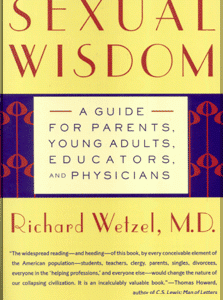
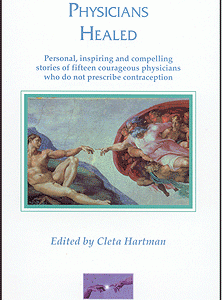

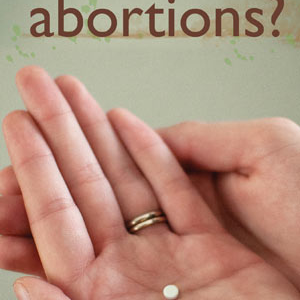

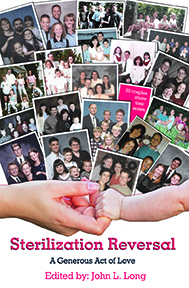
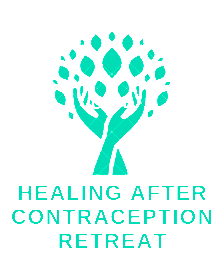
Pro-life group asks Ohio-based Catholic hospital system to cut ties with local abortionists
BY KIRSTEN ANDERSEN, Fri Nov 22, 2013
COLUMBUS, OH, November 22, 2013 (LifeSiteNews.com) – Pro-life activists in the Columbus area are mounting a petition drive to ask Catholic-affiliated Mount Carmel Hospital to sever its relationships with several local abortionists, in deference to church teaching opposing abortion.
According to Right to Life of Greater Columbus, Mount Carmel allows at least two, possibly three, abortionists to maintain admitting privileges at the hospital, despite its Catholic affiliation.
In Ohio, state law requires abortion providers to maintain admitting privileges at a nearby hospital in order to legally perform the procedure. By allowing these abortionists transfer privileges, the hospital is effectively helping them stay in business.
In the past, the group says they have directed questions about Mt. Carmel’s policy on admitting privileges to hospital officials. But after learning that the hospital had begun actively referring patients to doctors and facilities that perform abortions, they decided they had to act.
The group is asking pro-life supporters to sign on to a petition they have composed and will be sending to hospital president Claus von Zychlin, asking him to sever all ties with two known abortionists, along with a third doctor who works out of an abortion facility.
“As members of the local prolife community, we strongly appreciate Mt. Carmel’s commitment and mission to ‘… serve together at Mount Carmel in Trinity Health, in the spirit of the Gospel, to heal body, mind and spirit, to improve the health of our communities, and to steward the resources entrusted to us’ while adhering to a moral ethic that upholds the innate dignity due to every human from the moment of conception until natural death,” the petition reads. “We know you are serious when you say ‘Mount Carmel conducts all of its operations and patient care in a manner that is consistent with our Mission and values.’ We sincerely appreciate that you have placed all medical staff on notice that they are to ‘abide by generally recognized standards of medical and professional ethics including, but not limited to, the Ethical and Religious Directives for Catholic Healthcare.’”
“Recently, it has come to our attention that Mt. Carmel hospital’s online physician referral page refers patients to several physicians and facilities that demonstrably violate our shared respect for human life,” the petition states. “It is our goal to bring these concerns to your attention in the fervent hope that you will use your positions of leadership to make the necessary changes in light of these oversights and implement institutional safeguards to prevent future lapses.”
The petition goes on to name three local doctors connected to abortion: known abortionists Milroy Samuel and Karl Shaeffer, and a third doctor, Patrick Muffley, who has worked at Samuel’s abortion facility in the past.
All three doctors have spotty records when it comes to the safety of their female patients. Investigators at Milroy Samuel’s Complete Health Care for Women abortion clinic found rusted and dirty IV equipment, improperly sterilized surgical tools, expired medications, and lax infection control standards in 2012.
Karl Shaeffer’s Founder’s Women’s Health abortion facility was cited by health inspectors that same year for unsafe operating rooms and dangerous equipment, including patient tables that shocked patients when connected to electricity. Some staff at Shaeffer’s facility had expired surgical licenses, and in some cases, could not even prove they had a valid medical license at all.
Patrick Muffley is facing a 60 day suspension of his medical license for allegedly sending inappropriately sexual text messages to a patient.
Noting that hospital-affiliated abortionists have “greatly profited off the blood of the unborn,” the petitioners request that hospital executives “review the physicians mentioned above and the scope of their practices and take the appropriate action to disassociate Mount Carmel from the bloody abortion industry.”
To sign the petition to Mount Carmel, click here.
Posted in News & Commentary | No Comments »